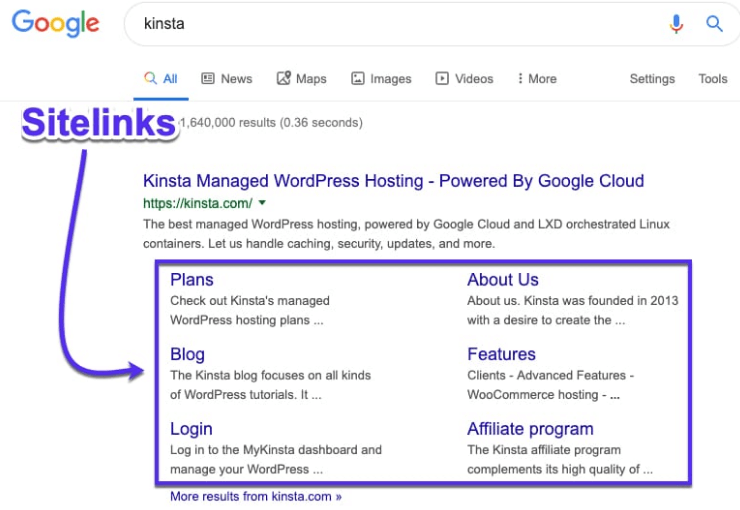The internet is a vast and complex network of websites, each offering its own unique value to users. With so many options available, it can be overwhelming for users to navigate through different pages and find the information they need. That’s where sitelinks come in – these handy navigational links are designed to make it easier for users to move around a website quickly and efficiently. In this article, we’ll explore what sitelinks are, how they improve user experience, why some websites have more than others, and how you can increase the number of sitelinks on your site. So buckle up and get ready as we take a deep dive into the world of sitelinks!
What are sitelinks?
Sitelinks are additional links that appear beneath the main search result for a website on Google. They provide users with direct access to specific pages within the site, allowing them to quickly find what they’re looking for without having to navigate through multiple menus or pages.
These links typically appear in a row below the main search result and may include several different options such as About Us, Contact Us, Services, Products, etc. The exact number and order of sitelinks can vary depending on the content of each individual website.
One important thing to note is that not all websites have sitelinks displayed under their search results. In most cases, it’s up to Google’s algorithms to determine whether or not a site qualifies for this feature based on various factors like its relevance and popularity.
While sitelinks were originally designed primarily for navigational purposes, they also serve as an excellent way for businesses and organizations to highlight specific sections of their website directly in Google’s search results page.
How can sitelinks improve the user experience?
Sitelinks are a great way to enhance the user experience on your website. They allow users to quickly access important pages within your site without having to navigate through menus or search for specific links.
By providing sitelinks, you’re giving users a streamlined and efficient way of finding relevant information. This not only saves them time but also creates a more positive impression of your brand.
In addition, sitelinks can help improve engagement and reduce bounce rates by guiding users towards pages they may not have otherwise discovered. By highlighting key content in this way, you’re encouraging visitors to explore more of what your site has to offer.
Furthermore, sitelinks can also increase trust and credibility among users by showcasing important pages such as About Us or Contact Us. This helps build relationships with potential customers and gives them confidence in your business.
Implementing sitelinks is an effective strategy for improving the user experience on your website. It allows for quicker navigation, increased engagement and ultimately builds trust with visitors.
Why do some websites have more sitelinks than others?
Sitelinks are an essential tool for website owners who want to improve the user experience and make their content more accessible. However, not all websites have the same number of sitelinks. So, why do some websites have more sitelinks than others?
Firstly, it’s worth noting that Google decides which sites get sitelinks based on several factors. One of these is the site’s structure – if a website has a clear hierarchy with distinct categories and subpages, it’s more likely to be awarded sitelinks.
Another factor is the popularity of specific pages on a site. If certain pages receive high levels of traffic or have many backlinks pointing towards them, they’re more likely to be featured as sitelinks.
Having well-optimized content can also play a part in earning sitelinks. Websites that consistently provide quality content and use relevant keywords throughout their site are seen as authoritative by search engines like Google.
In summary, there isn’t one single reason why some sites have more sitelinks than others. It often comes down to having a well-structured website with popular pages and regularly optimized content.
How can you increase the number of sitelinks for your website?
To increase the number of sitelinks for your website, there are a few strategies you can implement. First and foremost, ensure that your site is well-structure with clear navigation. This means organizing content into relevant categories and using descriptive anchor text for internal links.
Another strategy to increase sitelinks is to optimize your meta descriptions and title tags. These elements provide search engines with information about the content on each page of your site, and including relevant keywords can help improve their visibility in search results.
In addition, creating high-quality content that provides value to users can also help increase the likelihood of sitelinks appearing for your site. This includes regularly updating blog posts and other pages on your site with fresh, informative content.
Building backlinks from reputable sources can also signal authority to search engines and potentially result in more sitelinks being display for your site.
By implementing these strategies consistently over time, you may see an increase in the number of sitelinks displayed for your website in search engine results pages (SERPs).
Conclusion
Sitelinks are a crucial element of website design and user experience. By providing quick access to important pages on your website, you can improve navigation and increase engagement with your content. However, obtaining sitelinks is not guarantee and requires effort in optimizing your website’s structure, creating quality content, and building backlinks.
As the internet continues to evolve, it’s becoming more important than ever for websites to stand out from the competition. By incorporating sitelinks into your website strategy, you can provide users with a seamless browsing experience while also increasing visibility on search engine results pages.
So don’t overlook the importance of sitelinks. They could be the key to unlocking higher engagement rates and improved SEO performance for your website.





